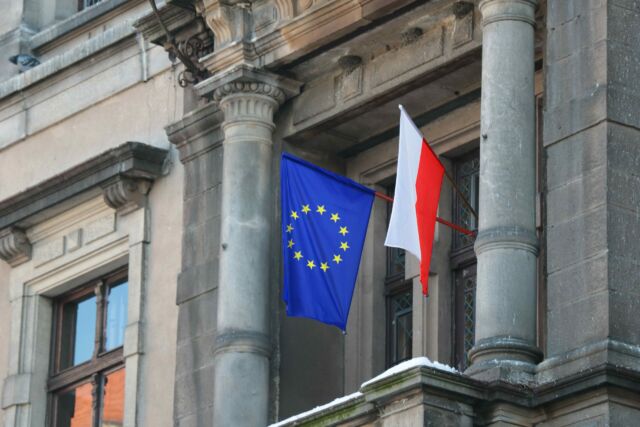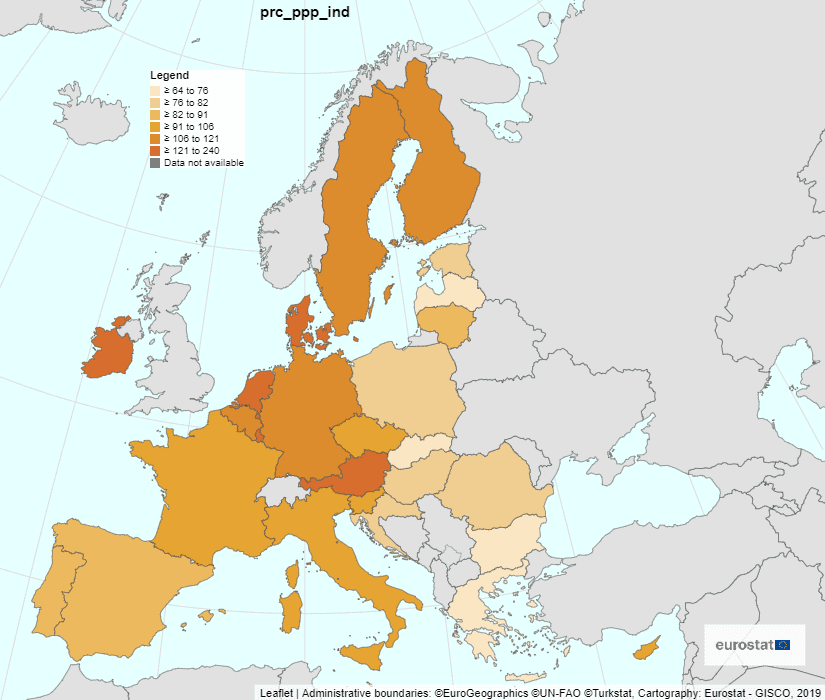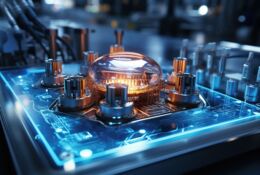Poland's GDP is already 80% of the EU average
04.04.2024
Eurostat has presented data on Gross Domestic Product per capita at purchasing power parity. Poland’s results are very good – our economy recorded further growth, reaching an unprecedented level of 80% of the EU average. In 2004, when Poland became a member of the European Union, this level was about 51% of the EU average.

Poland in 5th place
Data published by Eurostat indicate that the measure in question has increased by 7pp in Poland since 2019. This is the 5th highest result among the EU countries analysed. In our region, the Czech Republic (91% of the EU average, down 2pp compared to 2019), Lithuania (87%, up 3pp compared to 2019) and Estonia (81%, down 2pp since 2019) can boast higher scores. Only a small distance separates us from one of the country of the “old fifteen”. It’s Portugal (83% of the average in 2023). We have been ahead of Greece for a long time (67% of the EU average in 2023). In addition to the aforementioned Greece, 6 other EU countries had a rate lower than Poland in 2023. These were: Romania – 78%, Croatia and Hungary – 76%, Slovakia – 73%, Latvia – 71% and Bulgaria – 64%.

Diputible Leaders
The highest GDP per capita in 2023 was recorded by Luxembourg (261% of the EU average). Ireland came in second place (212% of the EU average). However, the performance of these countries is a separate matter. Their GDP is made up of factors such as the large number of foreigners employed, who are not residents. The second issue is the presence of international companies. A large part of their income returns to their owners based abroad.
The methods used to calculate GDP
GDP per capita is the ratio of the value of the Gross Domestic Product at current prices to the population of a given area.
GDP per capita according to PPP is the value of GDP per capita calculated at Purchasing Power Parity (PPP). It is expressed in the common currency PPS (Purchasing Power Standard) in relation to the average for the European Union set as equal to 100. The calculation takes into account differences in the price level from country to country.
PPS (purchasing power standard) is a contractual currency used by Eurostat to eliminate the impact of differences in price levels between countries. It makes it possible to compare and illustrate differences in the level of economic development.

Source: Eurostat, Macroeconomic analyses “Dziennik Ekonomiczny PKO BP, 27.03.2024 r.“
Spis treściTable of contents
- Everything
- News (289)
- Events (172)
- Get Support (83)
-

SOUTH LOGISTIC KARWAT STARĘGA SPÓŁKA KOMANDYTOWA
Transport and courier servicesShow allShow more Show lessFor over 10 years, we have been supporting European e-commerce businesses in their international growth. With our comprehensive logistics, returns, and system integration services, you can focus on sales while we take care of the rest.

Berrylife Szoka Kurlit sp.k.
Business servicesRenovation and construction materialsIT and telecommunication equipmentReady-made furniture and parts thereofOther goodsShow allShow more Show lessBerrylife – Trade Fair Booth Innovation Experts Berrylife creates innovative trade fair booths and exhibition stands that combine architecture, multimedia, and AI. We design and build custom booths that attract visitors, adapt to audiences, and deliver measurable results. With interactive screens, data-driven storytelling, and cutting-edge technology, we transform every exhibition booth into a powerful marketing tool for brands at international fairs.
 Article
ArticlePoland’s export of electrical and electronic equipment
Dynamic growth in the importance of these sectors

ZAKŁAD PRODUKCJI CUKIERNICZEJ JIW L.HOLEWA R. HOLEWA SPÓŁKA JAWNA
Baked goods and sugar confectioneryShow allShow more Show lessJIW Confectionery is a family-owned Polish company with over 30 years of experience in producing high-quality cookies. We offer a wide range of export-ready products, with a focus on our Cornetti Croccanti line – crispy and creamy cone-shaped cookies available in various popular flavors. We work with distributors, importers, and wholesalers across Europe.
-
 Article
ArticlePoland’s export of electrical and electronic equipment
Dynamic growth in the importance of these sectors
 Article
ArticleProduction and export of milk and dairy products in the first half of 2025
Polish exports of dairy products in the first half of 2025 reached EUR 2.1 billion
-
 Event
Event3rd International African Congress
The Congress will take place in Toruń (Poland) on February 25-27, 2026
 Event
EventPAIH Business Forum 2025
PAIH invites you to an event called PAIH Business Forum 2025, which will take place between the 5th–…
-
 Institution
InstitutionThe Investor Tax Service Center
The Investor Tax Service Center is a unit operating within the Ministry of Finance
 Institution
InstitutionPolish Investment and Trade Agency (PAIH)
The Polish Investment and Trade Agency (PAIH) is the partner of first-resort for entrepreneurs when …
The Export Promotion Portal uses cookies to make it easier for users to use the website and for statistical purposes. If you do not block these files, you agree to their use and saving in the memory of your computer or other device. Remember that you can change your browser settings to block the storage of cookies. More information can be found in Privacy Policy and Terms and conditions.





